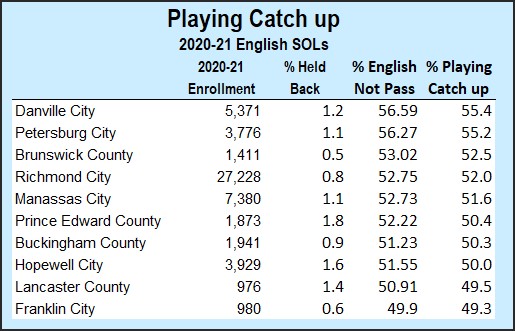Thanks to the Standards of Learning exams, Virginians have been able to measure the calamitous effects that the shutdown of in-person instruction had on student learning in the 2020-21 school year. From this year’s SOL exams, we will find out if students have made up for lost ground — or have fallen further behind grade level — while back in school this year.
Over and above teaching students what they need to learn for the current school year, the great challenge for schools and teachers has been helping them catch up on what they had failed to learn during the COVID-19 shutdowns. You see, almost everyone got a special COVID-19 dispensation and was allowed to move up to the next grade.
The Virginia Department of Education (VDOE) maintains two databases that allow us to gauge the magnitude of the challenge. One data set allows us to compute the percentage of students who fail to pass their exams. In numerous school districts, the percentage who failed their English reading exam, for example, exceeded half the student body. Once upon a time, students who failed to achieve basic mastery of core subjects were held back. A second VDOE data set tracks that number. In not one school district did the percentage exceed 3% in 2020-21.
Thus, in the Danville public schools, 56.6% of students failed their English SOLs (and 70% failed their math SOLs), but only 1.2% of students were held back. Assuming the number of held-back students was distributed randomly across all grades, we can conclude that more than half of all Danville students were promoted to the next grade without having mastered core subject matter.
Statewide, 31% of students failed their English reading SOLs in 2020-21. But there was enormous variability between school districts and even more between schools. The table atop this post shows the 10 schools with the highest percentages of kids playing catch up. The failing kids tend to be concentrated in high-poverty schools.
High-poverty schools in Virginia already have the odds stacked against them. Disciplinary issues are more rampant, and teachers spend more time maintaining order in the classroom. These schools also are more likely to be short-staffed, and teachers are more likely to double up on classes. And because substitute teachers are harder to find, doubled-up teachers often find themselves filling in classes for subjects in which they have no background. Very little teaching occurs.
When teachers in high-poverty schools have heavier teaching loads, and half or more of their students have been socially promoted, and kids are glued to their cellphones during class, and disproportionate attention is diverted to the trouble-makers whom the administration refuses to suspend, what are the odds that kids will make up lost ground? I’m not a teacher, but I’d say the odds are pretty slim.
Hopefully, we will see learning recovery in more affluent school districts less afflicted by teacher shortages, disorderly kids, and high percentages of students requiring remedial work. But it will take a super-human effort to avoid even greater learning loss in low-income schools. If Danville, Petersburg and Richmond can regain lost ground, let me applaud them in advance because the odds against them — sometimes due to outside factors, sometimes to policies they inflict upon themselves — are horrendous.


Leave a Reply
You must be logged in to post a comment.